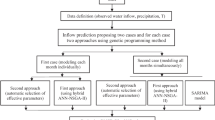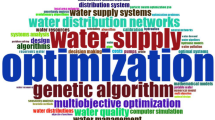Abstract
A technique for leakage reduction is pressure management, which considers the direct relationship between leakage and pressure. To control the hydraulic pressure in a water distribution system, water levels in the storage tanks should be maintained as much as the variations in the water demand allows. The problem is bounded by minimum and maximum allowable pressure at the demand nodes. In this study, a Genetic Algorithm (GA) based optimization model is used to develop the optimal hourly water level variations in a storage tank in different seasons in order to minimize the leakage level. Resiliency and failure indices of the system have been considered as constraints in the optimization model to achieve the minimum required performance. In the proposed model, the results of a water distribution simulation model are used to train an Artificial Neural Network (ANN) model. Outputs of the ANN model as a hydraulic pressure function is then linked to a GA based optimization model to simulate hydraulic pressure and leakage at each node of the water distribution network based on the water level in the storage tank, water consumption and elevation of each node. The proposed model is applied for pressure management of a major pressure zone with an integrated storage facility in the northwest part of Tehran Metropolitan area. The results show that network leakage can be reduced more than 30% during a year when tank water level is optimized by the proposed model.
Similar content being viewed by others
References
Ainola L, Koppel T, Tiiter T, Vassiljev A (2000) Water network model calibration based on grouping pipes with similar leakage and roughness estimates. In: Proceedings of the EWRI-ASCE congress, Minneapolis, Minnesota, USA
Aly AH, Peralta RC (1999) Optimal design of aquifer cleanup systems under uncertainty using a neural network and a genetic algorithm. Water Resour Res 35(8):2523–2532. doi:10.1029/98WR02368
Araujo LS, Coelho ST, Ramos HM (2003) Estimation of distributed pressure-dependent leakage and consumer demand in water supply networks. In: Maksimovic C, Butler D, Memon A (eds) Advances in water supply management. Swets & Zeitlinger, Lisses, pp 119–128
Asadiyani Yekta AH (2005) A software tool to calculate the unaccounted for water in water distribution networks. MSc thesis, Civil Engineering Department, University of Tehran, Iran
Broad DR, Dandy GC, Maier HR (2005) Water distribution system optimization using metamodels. J Water Resour Plan Manage ASCE 131(3):172–180. doi:10.1061/(ASCE)0733-9496(2005)131:3(172)
Burrows R, Mulried G, Hayuti M (2003) Introduction of a fully dynamic representation of leakage into network modeling studies EPANET. In: Maksimovic C, Butler D, Memon A (eds) Advances in water supply management. Swets & Zeitlinger, Lisses, pp 109–118
Damas M, Salmeron M, Ortega J (2000) ANNs and GAs for predictive controlling of water supply networks. In: Proceedings of the international joint conference on neural networks, pp 365–370
Dandy GC, Engelhardt MO (2001) Optimal scheduling of water pipe replacement using genetic algorithms. J Water Resour Plan Manage ASCE 127(4):214–223
Dandy GC, Engelhardt MO (2006) Multi-objective trade-offs between cost and reliability in the replacement of water mains. J Water Resour Plan Manage ASCE 132(2):79–88. doi:10.1061/(ASCE)0733-9496(2006)132:2(79)
Dandy GC, Simpson AR, Murphy LJ (1996) An improved genetic algorithm for pipe network optimization. Water Resour Res 32(2):449–458. doi:10.1029/95WR02917
De Jong KA (1975) An analysis of the behavior of a class of genetic adaptive systems. Doctoral dissertation, University of Michigan, Dissertation Abstract International 36(10), 5140B (University Microfilms No. 76-9381)
De Schaetzen W, Savic DA, Walters GA (1998) A genetic algorithm approach to pump scheduling in water supply systems. In: Babovic V, Larsen L (eds) Hydroinformatics’98. Balkema, Rotterdam, pp 897–899
Engelbrecht R, Haarhoff J (1996) Optimization of variable-speed centrifugal pump operation with a genetic algorithm. In: Abousleiman Y, Brebbia C, Cheng A-D, Ouazar D (eds) Computer methods and water resources III. Computational mechanics, Southampton, pp 497–504
Farley M, Trow S (2003) Losses in water distribution networks. IWA, London
Geem ZW (2003) Window-based decision support system for the water pipe condition assessment using artificial neural network. In: Proceedings of world water & environmental resources congress
Gerald CF, Wheatley PO (1994) Applied numerical analysis. Addison-Wesley, Reading, MA
Germanopoulos G (1985) A technical note in the inclusion of pressure dependent demand and leakage terms in water supply network models. Civ Eng Syst 2(3):171–179. doi:10.1080/02630258508970401
Gibbs MS, Morgan N, Maier HR, Dandy GC, Holmes M, Nixon JB (2003) Use of artificial neural networks for modeling chlorine residuals in water distribution systems. In: Proceedings of the international congress on modeling and simulation. Modeling and Simulation Society of Australia and New Zealand Inc, Townsville, Australia, 2, pp 789–794
Goldberg D (1989) Genetic algorithms in search, optimization and machine learning. Kluwer Academic, Boston, MA
Goldberg D, Kuo C (1987) Genetic algorithms in pipeline optimization. J Comput Civ Eng 1(2):128–141. doi:10.1061/(ASCE)0887-3801(1987)1:2(128)
Holland JH (1975) Adaption in natural and artificial systems. University of Michigan, Ann Arbor
Johnson VM, Rogers LL (1995) Location analysis in ground-water remediation using neural networks. Ground Water X3(5):749–758. doi:10.1111/j.1745-6584.1995.tb00021.x
Kalagnanam JR, Diwekar UM (1997) An efficient sampling technique for off-line quality control. Technometrics 39(3):308–319. doi:10.2307/1271135
Karamouz M, Kerachian R (2003) Water quality planning and management. Amirkabir University Press, Tehran
Lambert A (1997) Pressure management/leakage relationships: theory, concepts and practical applications. In: Proceedings of minimizing leakage in water supply/distribution systems, IQPC Seminar, London
Leshno M, Lin VY, Pinkus A, Schocken S (1993) Multilayer feed forward networks with non polynomial activation function can approximate any function. Neural Netw 6:861–867. doi:10.1016/S0893-6080(05)80131-5
Lingireddy S, Ormsbee LE (1998) Neural networks in optimal calibration of water distribution systems. In: Flood I, Kartam N (eds) Artificial neural networks for civil engineers: advanced features and applications. ASCE, Reston, VA, p 277
Mackle G, Savic DA, Walters GA (1995) Application of genetic algorithms to pump scheduling for water supply. In: Proceedings of the genetic algorithms in engineering systems: innovations and applications GALESIA’95, IEE Conf. Publ. No. 414, Sheffield, UK, pp 400–405
Miettinen K, Neittaanmaki P, Makela MM (1999) Evolutionary algorithms in engineering and computer science. Wiley, New York
Mounce SR, Day AJ, Wood AS, Khan A, Widdop PD, Machell J (2002) A neural network approach to burst detection. Water Sci Technol 45(4–5):237–246
Rao Z, Alvarruiz F (2007) Use of an artificial neural network to capture the domain knowledge of a conventional hydraulic simulation model. J Hydroinform 9(1):15–24. doi:10.2166/hydro.2006.014
Schwab M, Savic DA, Walters GA (1996) Multi-objective genetic algorithm for pump scheduling in water supply systems. Rep. No. 96/02, Univ. of Exeter, Exeter, UK
Simpson AR, Dandy GC, Murphy LJ (1994) Genetic algorithms compared to other techniques for pipe optimization. J Water Resour Plan Manage ASCE 120(2):423–443
Tabesh M (1998) Implications of the pressure dependency of outflows on data management, mathematical modelling and reliability assessment of water distribution systems. PhD thesis, Department of Civil Engineering, University of Liverpool, England
Tabesh M, Dolatkhachi A (2006) Effects of pressure dependent analysis on quality performance assessment of water distribution networks. Iran J Sci Technol Trans B Technol 30(B1):119–128
Tabesh M, Goosheh S, Yazdanpanah MJ (2007) Application of artificial neural networks on estimation of short-term urban water demand. J Fac Eng Univ Tehran 41(1):11–24
Tabesh M, Asadiyani Yekta AH, Burrows R (2009) An integrated model to evaluate losses in water distribution networks. J Water Resour Manage 23:477–492
Todini E (2000) Looped water distribution networks design using a resilience index based heuristic approach. Urban Water 2:115–122. doi:10.1016/S1462-0758(00)00049-2
Van Zyl JEV, Savic DA, Walters GA (2004) Operational optimization of water distribution systems using a hybrid genetic algorithm. J Water Resour Plan Manage ASCE 130(2):160–170. doi:10.1061/(ASCE)0733-9496(2004)130:2(160)
Vela A, Perez R, Espert V (1991) Incorporation of leakages in the mathematical model of a water distribution network. In: Proceedings of the 2nd international conference on computer methods in water resources, Marrakesh, Morocco, 02/20–22/91, pp 245–257
Walters GA, Halhal D, Savic D, Quazar D (1999) Improved design of Anytown distribution network using structured messy genetic algorithms. Urban Water 1(1):23–38. doi:10.1016/S1462-0758(99)00005-9
Author information
Authors and Affiliations
Corresponding author
Rights and permissions
About this article
Cite this article
Nazif, S., Karamouz, M., Tabesh, M. et al. Pressure Management Model for Urban Water Distribution Networks. Water Resour Manage 24, 437–458 (2010). https://doi.org/10.1007/s11269-009-9454-x
Received:
Accepted:
Published:
Issue Date:
DOI: https://doi.org/10.1007/s11269-009-9454-x




